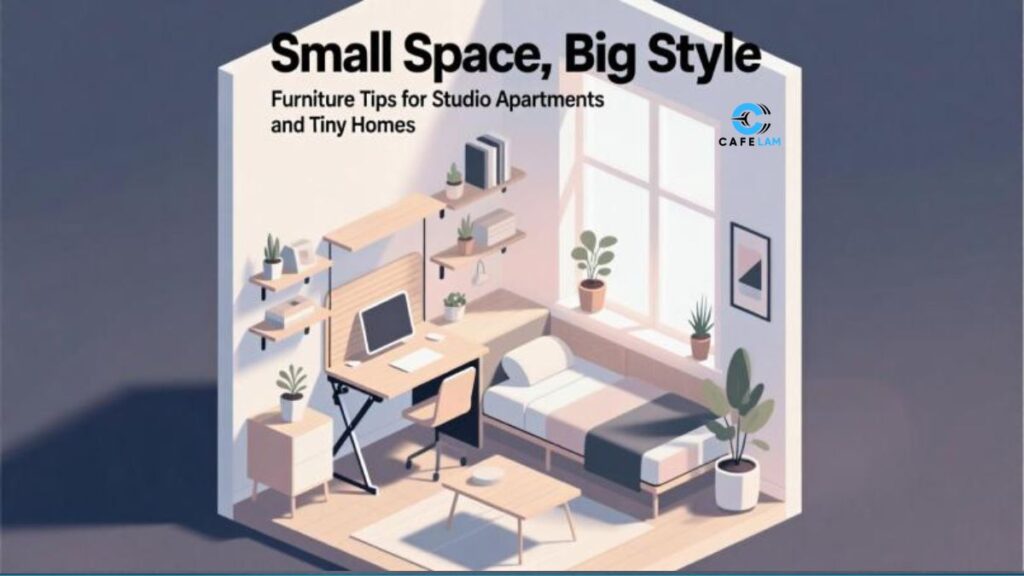When you live in a small space, every square inch matters. Whether you’re in a studio apartment, a converted loft, or a minimalist tiny home, the way you choose and arrange your furniture has a direct impact on how livable—and stylish—your space feels.
But having less space doesn’t mean you have to compromise on function or personality. In fact, small spaces often offer the biggest creative opportunities when it comes to furniture selection and interior design.
With the right mindset and smart choices, it’s possible to create a home that feels open, comfortable, and uniquely yours.
Choose Furniture With Multiple Functions
When floor space is limited, every item in your home should serve more than one purpose. This is where multifunctional furniture becomes your best friend.
- A sofa bed doubles as both seating and sleep space
- Storage ottomans hide blankets, shoes, or books
- Drop-leaf tables offer dining options without taking up permanent space
- Lift-top coffee tables create hidden storage and even desktop surfaces
Every piece should earn its spot. Ask yourself: “Does this do more than one thing for me?” If not, keep browsing. A trusted local furniture store can often help you find pieces designed specifically for space efficiency.
Think Vertically, Not Just Horizontally
Limited floor space doesn’t mean limited storage—it just means you need to look up.
Tall shelving units, wall-mounted desks, and hanging planters free up floor area while making use of otherwise wasted vertical space. For open shelving, use decorative baskets or matching containers to avoid visual clutter.
Furniture that visually draws the eye upward also helps make a small space feel taller. Choose bookcases and storage units that reach near the ceiling to stretch the room’s sense of height.
Keep It Light—In Both Color and Design
Heavy furniture can weigh down a small room. Instead, opt for pieces with exposed legs, open bases, or slim profiles. This creates the illusion of more space, as light is able to pass through and around each item.
Color also plays a key role. Lighter tones—like whites, soft grays, and pale woods—reflect light and help make rooms feel larger. If you love darker tones, balance them with mirrors or metallic accents to maintain brightness.
Even glass and acrylic furniture can be useful in tight quarters. A clear coffee table, for example, offers full function without interrupting visual flow.
Invest in the Right Sofa
Sofas often take up the most real estate in a small space, so choose wisely. Look for:
- Low-profile frames: They feel less bulky
- Tight-back cushions: They save depth and offer a clean look
- Armless styles or loveseats: Better for tight corners
- Neutral upholstery: Allows for greater styling flexibility
When in doubt, visit a local furniture store and try different sofa configurations. Modular sofas, especially those that allow for separation or reconfiguration, are excellent for evolving living arrangements.
Get Creative With Room Dividers
One of the biggest challenges in a studio or tiny home is separating zones—especially when everything from sleeping to eating happens in the same open space.
Here are some smart, stylish divider ideas:
- Tall bookcases that also provide storage
- Curtains or fabric panels hung from ceiling tracks
- Folding screens that can be tucked away when not in use
- Freestanding shelving units that let light through while segmenting space
These dividers give each zone a defined purpose while maintaining an open and breathable layout.
Scale Is Everything
Choosing furniture that fits the scale of your space is non-negotiable. A full-size sectional in a 300-square-foot apartment will always feel cramped, no matter how beautiful it is.
Smaller-scaled furniture is designed to function without overpowering the room. This doesn’t mean sacrificing comfort—it means being intentional.
Look for petite armchairs, round tables, nesting side tables, and even slender dining chairs that visually balance with the space. If you’re unsure, professionals at a reputable furniture store can guide you through size options you might not find online.
Use Mirrors and Reflective Surfaces
Mirrors are the oldest trick in the book for making a small space feel bigger—and for good reason. They reflect light, expand sightlines, and add an element of elegance.
Hang a large mirror across from a window to maximize natural light, or place one near the dining area to double the feeling of space during gatherings.
In addition to mirrors, look for furniture with reflective surfaces: chrome legs, metallic details, and high-gloss finishes all bounce light and reduce visual density.
Keep Storage Hidden and Organized
Clutter is the enemy of small-space living. To stay stylish and sane, choose furniture with hidden storage:
- Beds with drawers
- Benches that open
- Coffee tables with compartments
- Console tables with built-in organizers
The more you can store out of sight, the more calm and curated your home will feel.
What’s New Furniture carries a wide selection of space-saving furniture that blends functionality with clean design, ideal for urban dwellers and small-space homeowners alike.
Customize Where Possible
One size does not fit all—especially in tight quarters. Custom-built furniture or modular collections allow you to tailor every piece to your needs and floorplan.
For example, a built-in bench with storage in an awkward corner can eliminate the need for extra chairs or cabinets. Or a wall-mounted fold-down desk can transform a hallway into a temporary home office.
Customization doesn’t always mean “expensive”—it just means thoughtful. Even rearranging pieces in unconventional ways can give a fresh perspective.
Final Thoughts
Living in a small space doesn’t mean compromising on comfort, style, or function. In fact, it gives you the perfect opportunity to become more intentional with every item you bring into your home.
It’s about maximizing space without minimizing personality. About investing in furniture that works hard for you—and makes your space feel like it’s working with you, not against you.
When you’re ready to reimagine your layout, a visit to a thoughtfully curated furniture store can provide not just pieces, but ideas. And if you’re looking for modern, space-efficient inspiration, What’s New Furniture offers a selection that blends style with small-space sensibility.







